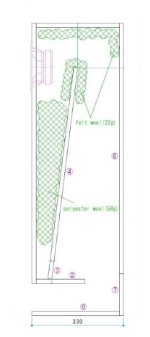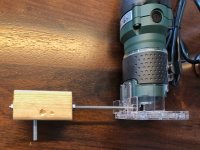Replacement screen door mesh is also available in plastic, IINM.I doubt it. Variations on that, fishing-line strung across from eyelets etc. are fairly common in straight or expanding QW pipes to stop damping material falling down to the base!
Never damp the output line for maximum performance!
Example:
I think it would be better to have the [A] polyfill for general TQWT, including Sibelius.
I don't use [A] because I make the opening into a duct shape and apply a mass loaded.
so it would be smart to glue a mesh mat into the Sibelius pipe, so that damping material can be added later if necessary?I think it would be better to have the [A] polyfill for general TQWT, including Sibelius.
I don't use [A] because I make the opening into a duct shape and apply a mass loaded.
View attachment 1369589
nice router. what make is it?
how do you adjust the radius accurately, repeatably and securely?
how do you adjust the radius accurately, repeatably and securely?
not necessaryso it would be smart to glue a mesh mat into the Sibelius pipe, so that damping material can be added later if necessary?
what is the minimum diameter you can fraze with this thing?tool for frazen driver hole ready. now waiting for the 32mm oak…
Re damping: How much and where it goes is heavily dependent on room, taste, and in the case of the “sibelius” clone, how badly marched the driver is to the line.
Functionality of damping materials vary greatly, some polyfluffs are not great, things like acustastuff are really decent and consistent.
At either end of scale we have a BIB which needs a lot and very carefully placed damping, to a Metronime which often want VERY little.
Add to that, the polyfluff needs proper teasing. More often than not i see big wads of insufficiently teased polyfluff.
There is too much variability in the damping to be ableto specify much.
Denoding on the damping used, some supports so that it does not sag. particularily true if you use sheepswool. Well teased acouistastuff statys preety much where you put it. A mix of some acoustasuff withthe sheep’s wool tends to stay in place.
dave
Functionality of damping materials vary greatly, some polyfluffs are not great, things like acustastuff are really decent and consistent.
At either end of scale we have a BIB which needs a lot and very carefully placed damping, to a Metronime which often want VERY little.
Add to that, the polyfluff needs proper teasing. More often than not i see big wads of insufficiently teased polyfluff.
There is too much variability in the damping to be ableto specify much.
Denoding on the damping used, some supports so that it does not sag. particularily true if you use sheepswool. Well teased acouistastuff statys preety much where you put it. A mix of some acoustasuff withthe sheep’s wool tends to stay in place.
dave
Overall it's good what you think. The best is to built and test by yourself.
Yes, I build and test them.
For the DDVP series, I adjust the position and amount of sound-absorbing material installed to my liking.
Each user has a different taste in sound, so the use of sound-absorbing materials is different for each person.
so it would be smart to glue a mesh mat into the Sibelius pipe, so that damping material can be added later if necessary?
Hi Wil_NL,
It is Wil_NL who will be the judge of those things.
Damp as less as you can for the best performance.
Damping is a compromise between letting as much fundemental out the terminus, while still suppressing the unwanted ripple (higher harmonics).Too little damping then too much bass too much ripple.
dave
I wish you all the best with your self built Sibelius. I am ready and very happy with them. Thanks for joining and your comments. Kind regards from The Netherlands, Brielle. ;-)
Looks like Makita 3709?nice router. what make is it?
how do you adjust the radius accurately, repeatably and securely?
- Home
- Loudspeakers
- Full Range
- Pearl Acoustic Sibelius

